
Written by Simon Holloway (Bloor Software Analyst)
Simon’s a Bloor Software Analyst whose IT background spans some 30 years. He worked as an IT consultant specialising in IS/IT strategy planning, information management, corporate data and process modelling, business process reengineering, software selection and project management. More about Bloor...
Supply chain management (SCM) is the management of the flow of goods or services. SCM capability remains a critical concern for senior executives in 2015 and beyond; not least, because SCM is a vital element of many organizations’ value chains. Supply chain professionals face numerous issues in managing supply pipelines effectively. Some are traditional problems, like good IT systems capability. Others reflect the evolution of SCM in a more globalized world. The jet engine, the internet, and falling telecommunications costs have combined to create a global village, a new playing field which offers many new opportunities and challenges.
The best way to look at what is needed is to look at a scenario.
Over the last few months the issues of delays to lorries travelling across the English Channel caused by the refugee crisis has made the newspapers in Europe. Is there a way that an organisation can respond to a closure of a port so that it can keep its trucks moving or the closure of a tunnel due to fire?
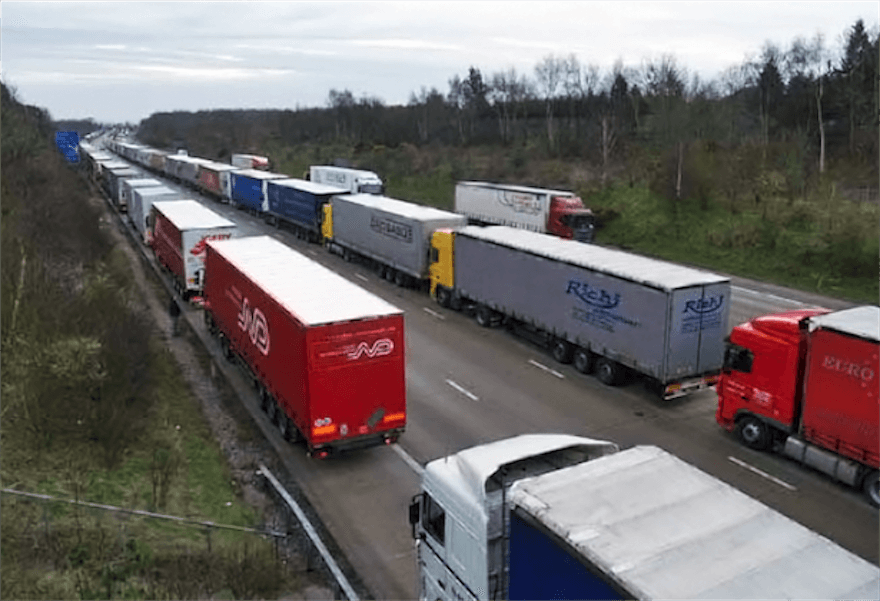
Imagine yourself a Logistics manager for a Scotch Whisky company based in the heart of the Scottish Highlands. Your company has just won an order to ship for the next 5 weeks a full mixed lorry of your products from your Edinburgh warehouse to a customer in Milan. So you sit down at your computer to plan the most cost-effective route to make the shipment. You sign on to your SCM system. This provides you with the functionality given some route points that you input to calculate the most cost-effective and quickest route to ship the goods. Unfortunately, this order has been won with the first shipment taking place in the first week of November. The quickest and cheapest route to Milan takes you through the Alps but the Mont Blanc tunnel is closed due fire damage. November in the Alps means snow. So you now have to sign on to the weather services for UK, France, Switzerland and Italy to check what the weather conditions are. Having got this information over the web you have to go back into your SCM system and make alterations to the recommended route as necessary. Next you have to sign on to the road conditions services for the UK, France, Switzerland and Italy to check if there are any major road works that could alter your chosen route. Once these are checked, you have to go back to the SCM system and make the necessary adjustments. Then you are ready to issue the route instructions to your driver for the first shipment.
This as you can see involves a laborious task of signing on and off various services to make your decision. If you used an integration tool or business process management software you could then link all these tasks together so that your SCM task automatically calls all the associated weather and road conditions services that you use and make them available to you with out you having to sign on to each of them individually. But in a Mobile SCM, the ability to refer to external sources for decision making would allow the calculation of the best route to check the weather and road conditions and make prompts to you to make decision. Or even make the readjustments to the route based on the way you have used the weather and road information in the past.
Let us take our scenario a stage further. You have done your route planning and you are driving home in you BMW 5 when suddenly on the car’s digital input screen you see the following message: “Hi Boss, Fred here. It looks like the Tunnel is to close. I am about 5 km away from Calais. Do you want me to reroute?” This message has come over the cab radio from Fred your driver returning from delivery in Germany. You stop the car and decide which device would be appropriate to make the route changes on; your Smartphone or your tablet with built in telephone and modem. You choose the latter because you want to look at where all your possibly affected lorries are. You select on your tablet a business process on your menu called “Tunnel Rerouting”. The first task it performs is find where all your inbound and outbound lorries are, both your own and your 3PL. From the map, you decide to reroute all lorries through Hook of Holland Hull route. The routes are pushed to the lorries input screens and fax printers by your mobile SCM software calling appropriate services to carry out the task. Your mobile SCM also contacts the ferry booking service that you use and cancels all the Dover Calais tickets you have for the next 3 days and purchases alternatively Hook of Holland Hull tickets. The changes of route mean that some of your deliveries will be delayed slightly so a message is sent to customers affected explaining the reason for the delay and the expected new arrival time. Sum of the route changes for inbound lorries will affect their availability to take planned loads, so the application presents you with the orders affected and the availability of your lorries and your 3PL. All you have done is plan the reroute the rest has happened automatically because that is how you have defined your service on demand business process.
Sounds far-fetched. Why? The technology to perform this has been around for the last 10 years or so. It is just that we haven’t put it all together, so we still end up with lorries in large queues awaiting the ability to go through the Tunnel, accompanied by unhappy customers. If one of our or our 3PL lorries is carrying temperature or time-sensitive goods then we could have a complete loss of the goods in question. What we need is software that allows us to respond to these sort of scenarios without rewriting of the software using rules management, process management and integration to achieve the desired support.
SCM is one of the areas of enterprise activity seeing the biggest impact from technology. While laggard organizations continue to grapple their Enterprise Resource Planning (ERP) requirements, the more nimble players have extended their leverage of technology in different domains, with significant benefits in operational performance, organizational capability, and cost efficiency. Examples include;
E-commerce – from e-auctions for sourcing a wider range of supplies to click-and-collect in retail supply chains. Also, integrating the use RFID into broader e-commerce capabilities is enabling seamless data flows, with greater accuracy and timeliness, even across organisational boundaries.
Supply chain analytics and ‘big data’ – Supply chain analytics software offerings continue to evolve in leaps and bounds, providing better end-to-end pipeline visibility and spend management. Knowledgeable businesses are now combining this capability with the exploitation of big data. This offers deeper insights to the marketplace and the supply base, allowing better alignment of SCM to the wider business environment, not least in the area of forecasting and demand management. Enhanced demand planning will remain a critical requirement, as organisations try to cope with the increased demand volatility created by economic uncertainty coupled with extended supply chain networks.
Cloud-based software applications – This has massive impacts for organizations, largely through much lower capital investment requirements, significantly reducing the total cost of ownership and, hence, greater return on investment. On-demand applications, or ‘software as a service’ (SaaS), is likely to mushroom once supply chain professionals can collaborate with their IT and Finance colleagues successfully to sell the business case to the boardroom. There is a need to be able to integrate easily different SaaS applications from different suppliers to meet the separate need of the business as a single solution from one supplier may not meets the complete needs of an organisation anymore.
Human factors – Technology is also likely to have a huge impact on supply chain jobs and human interactions. Some conventional SCM job roles are already being supplanted by technology, e.g., tactical planning and purchasing activities now require less manual intervention, hence headcount, with reliable IT systems capability. And social media will continue to Increase knowledge, benchmark awareness, and a different (although not necessarily better) sort of engagement dialogue with supply chain colleagues within the enterprise and supply partners externally. Remote devices like bar-code, RFID, NFC and other sensors mean we can pick up movements of goods in real-time without people necessarily being involved.
Service – For many organisations, the after-sales service that they supply associated with their products are as an important part of their revenue stream and also a key part of the customer relationship management. Therefore there is a need to provide SCM capabilities to extend to the vans and trucks associated with the service engineering staff. This has to be integrated with not only the works order but also with the inventory to create a complete integrated whole.
In Bloor’s view this means that we now need to move to a Mobile Supply Chain Management support. In too much of what I have read all that vendors see when they use the term “Mobile Supply Chain” is that their products is able to work on tablets and phone that use any of the three major platforms ( i.e. Apple, Android or Microsoft). But to me mobile supply chain is much more that just that; it means that the loads on vans, trucks and even cars can be managed in just the same way as a warehouse or a factory. It also has cover for inventory of an organization that is managed by a customer on their own premises. The workforce has to be able to operate from anywhere with whatever device they have available at the time to get the information they need to perform the task required. The way the software is architected has to allow for information to come from any device, be it human operated, by voice or by sensory device (e.g. RFID, Barcode). The software architecture has to be both flexible and adaptable so that business process and rules can be changed to reflect the changing circumstances of the market in a 24/7 manner, without the necessary involvement of IT staff.
In the white paper, Supply Chain Management in the 21st century, which I wrote in December 2014, I outlined all the different elements that incorporate a complete SCM solution. I identified the following pigeonholes for Supply Chain Management software which reflect the business flow through the supply chain at a low level of granularity:

Bloor has analysed some 104 products that support SCM and therefore this market review is a high level one and uses a technique that I derived as a way of providing a high-level view of support for software selection (for more details see Package Evaluation, Richard Sharland, Avebury Technical) to compare products called Bubble Diagrams. The information for each vendor’s product was discovered from public sources including the vendors’ web sites and independent product review web sites/reports. All the packages reviewed have some degree of supply chain master so I made the decision to not include in this high-level review. What I also noticed was that support for purchasing seemed to also mean support for order fulfillment, so I combined these into a “Purchase Management” bubble. All packages have some level of analysis support for the functionality they cover.

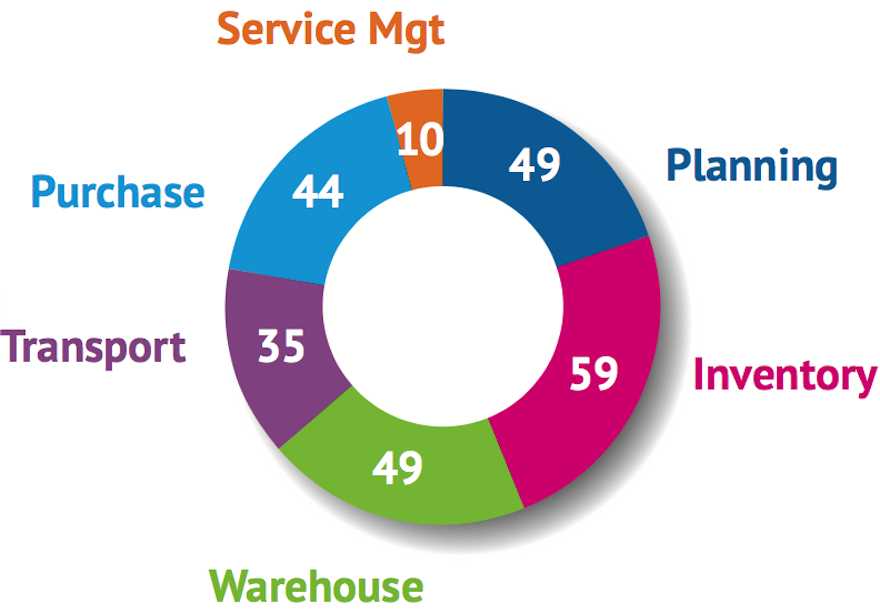
The first review shown in Figure 4 involved the analysis of the support by the products for Bloor SCM key functionality. The most supported area is inventory management followed by planning and warehouse management and then purchase management. Service management is the least supported and when the packages that supported this category were looked at in further details, only one, Apptricity, had the ability to treat vans and trucks like warehouses; this was supported by a good case study describing CenturyLink use of the software. All the other packages just covered service management from the point of view of orders and customers.
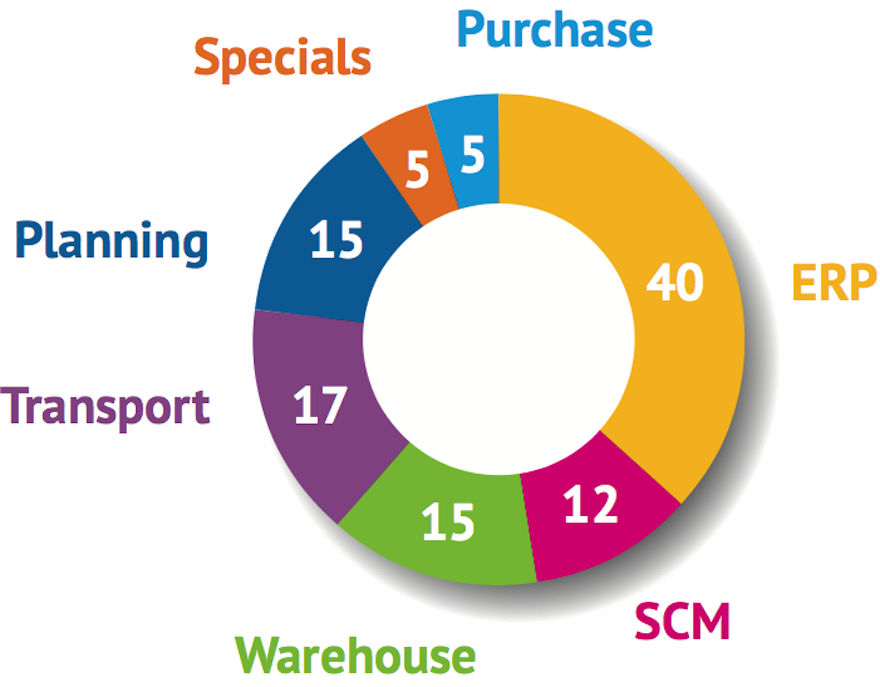
Support for SCM can also be broken down by viewing in terms of major software package categories used by the industry. SCM is a major component of ERP and as such all the major ERP vendors compete. What is interesting is some of them, like SAP, have also separated out their SCM component and market and sell it as a separate sku. This is also a market where there are a large number of vendor specialists who have made their name and their business in the SCM world either by marketing and selling to large enterprises or to the mid market. These vendors supply a package which covers the majority of the key functionality Bloor have suggested forms a complete SCM offering; we have used the category title of SCM to categories them. Planning, Inventory, Warehouse Management, Transport Management and Purchasing are the other major categories where a number of suppliers compete with their offerings.
Bloor identified some 40 ERP products that provided support for SCM. To understand these products, we decided to use the Tier Classification system. ERP Tiers are classifications of software by the size of the company they fit.
Tier 1 ERP software is software for the large enterprise. This includes multi-site, multi-national corporations. Typically the Tier 1 customer is a company with revenues in excess of $200 million dollars and has several sites, probably geographically dispersed and in multiple companies. Panorama Consulting in their 2014 review of ERP software1 identified 3 vendors who fit into this category: SAP with Business ByDesign, Business One and ERP; Oracle with e-Business Suite, JD Edwards EnterpriseOne and PeopleSoft; and Microsoft with Dynamics AX, Dynamics GP and Dynamics NAV. Figure 5 shows the support for Bloor’s SCM key functionality.
It is interesting to note that only three of these Tier 1 ERP solution provided support for transport management out of the box (Oracle’s e-Business Suite and JDC Edwards EnterpriseOne and Microsoft AX). Only one provided support for service management – Oracle e-Business Suite. Microsoft Dynamics GP had the smallest support for the functionality under review.
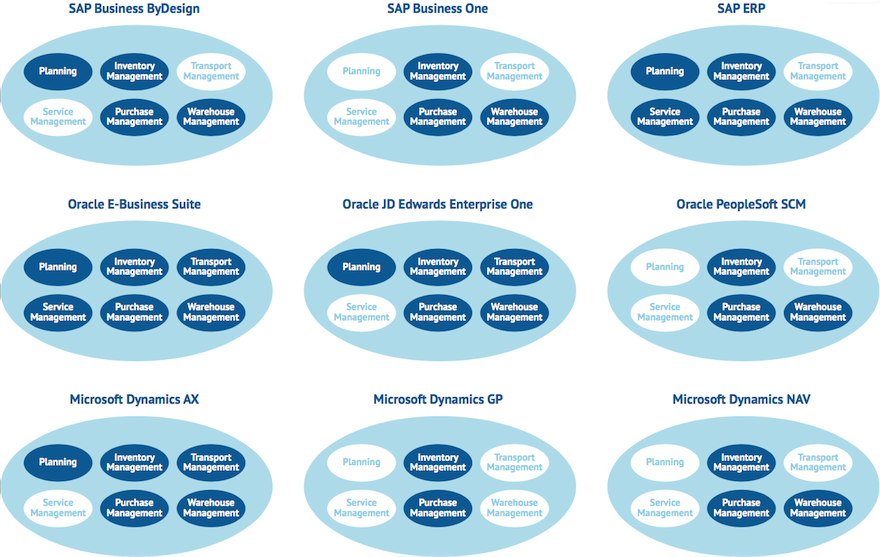
The Tier 2 market is the largest of all the tiers in terms of the number of potential customers. This is the mid-sized tier. The customers of Tier 2 software usually are in the $20 million to $200 million dollars. They are usually just a few localized sites. For example a company that has a main office in California, with a manufacturing facility in Ohio and a distribution outlet in Texas would be a typical Tier 2 client. Often though, Tier 2 customers are single site. The main indication is the size of the company by revenue. Panorama Consulting in their 2014 review of ERP software2 identified Aptean with Ross ERP; Epicor; Exact; IFS; Infor with LN, M3, Cloud Suite Industrial (SyteLine), System21, VISUAL and XA; IBS; IQMS; NetSuite; Pronto, QAD; Ramco; and Sage with 200-Extra and X3. I have added one other company to this category Excel EFACS/8. Figure 6 shows the support of these products for Bloor’s SCM key functionality.
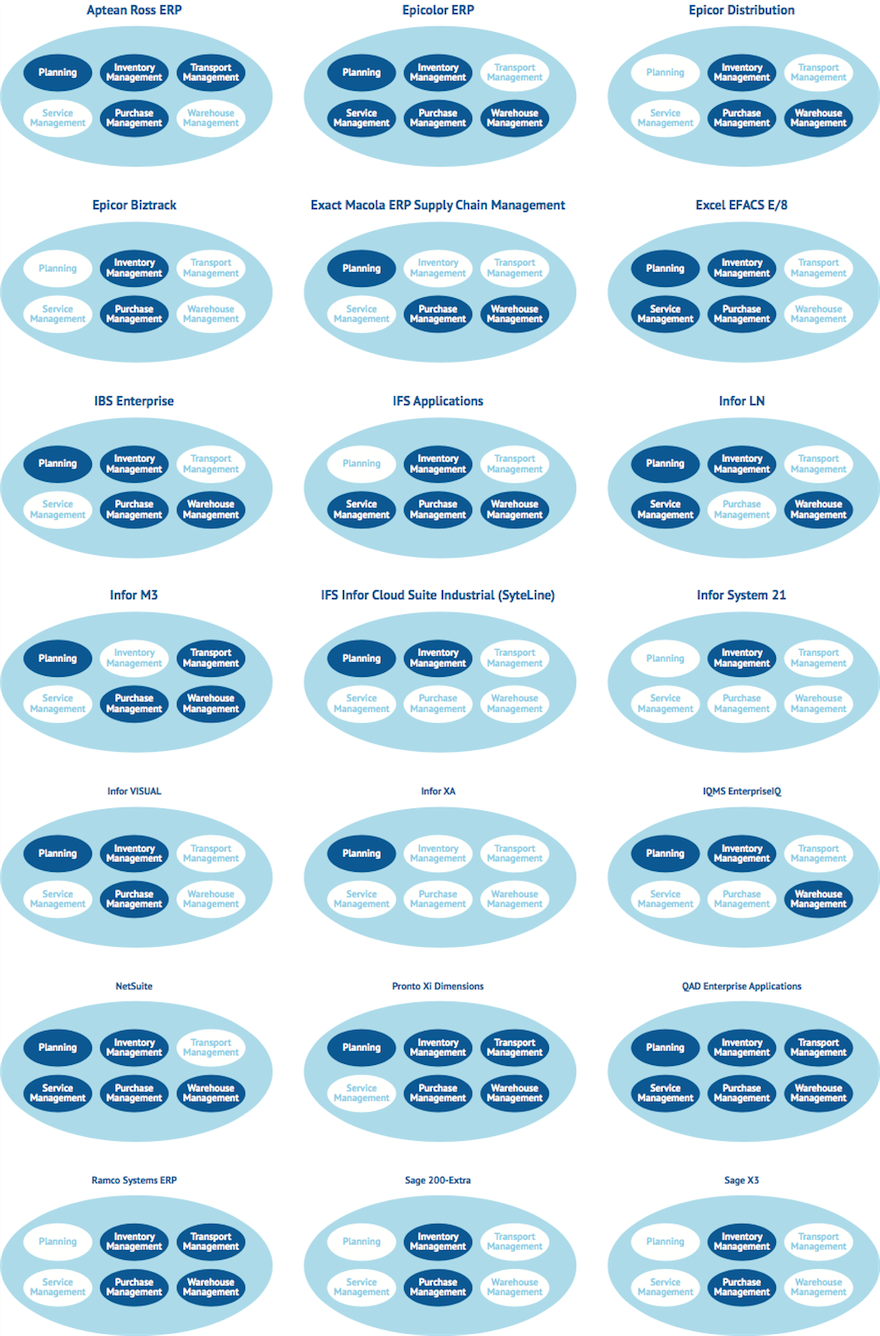
Only one of the Tier 2 ERP solutions reviewed provided support for all categories reviewed – QAD Enterprise Applications. Only five of the products reviewed provide support for transport management (Aptean Ross ERP, Infor M3, Pronto iX Dimensions, QAD and Ramco). Service management was supported by 6 of the products reviewed (Epicor, Excel, IFS, Infor LN, NetSuite and QAD), but in all cases did not cover support of trucks and vans as mobile warehouses. The worst support for SCM was from Infor XA and Infor System 21, and when looking at why this was the case, I identified that users requiring this functionality were being directed to use Infor Lawson SCM.
Tier 3 ERP software is designed for single site customers of under $40 million dollars. These are companies with 5 to 30 users and have less demanding needs. These companies tend to be the family run or small corporations. In the Bloor review of SCM these include: 3i Infotech, Apprise Software, Blinco Systems, Emerge-IT, IntegrateIT, Jesta I.S., K3, Lakeview Computers, SSL-WinMan and TOTVS. Figure 7 shows these products support for Bloor’s SCM key functionality.
Blinco and TOTVS provide the best SCM coverage of the Tier 3 ERP packages. Many of the rest reviewed only support 2 of the categories.

Bloor identified some 12 packages that style themselves “Supply Chain Management”. All of these packages do provide functionality that covers a majority of the pigeonhole categories I have recommended as making a complete Bloor SCM package. The packages reviewed included: Access Supply Chain Management; Apptricity Supply Chain Management; Aptean IMI Supply Chain, GT Nexus (now part of Infor) Nexus Enterprise Solutions; Infor Lawson SCM; JDA eight and Supply Chain Now; Logility Voyager Solutions; Manhattan Associates SCOPE; Production Modeling Corporation n.Skep; SAP SCM; and Zionex T3 Series. Figure 8 shows the support of these products for Bloor’s SCM key functionality.
Three of these products provide support for 5 of the 6 key functions; these are Appriticity Supply Chain Management, Aptean IMI Supply Chain and SAP SCM. It is interesting to note that SAP SCM provides support for transport management which is not covered in its ERP offerings. Only one of these solutions provided support for service management – Appriticity Supply Chain Management. Seven of the reviewed packages provided support for transport management (Appriticity Supply Chain Management, Aptean IMI Supply Chain, Infor Lawson SCM, Logility Voyager Solutions, Manhattan Associates SCOPE, Production Modeling and SAP SCM). Four of the packages did not provide support for purchase management (JDC eight, Logility Voyager Solutions, Manhattan Associates SCOPE and Production Modeling).
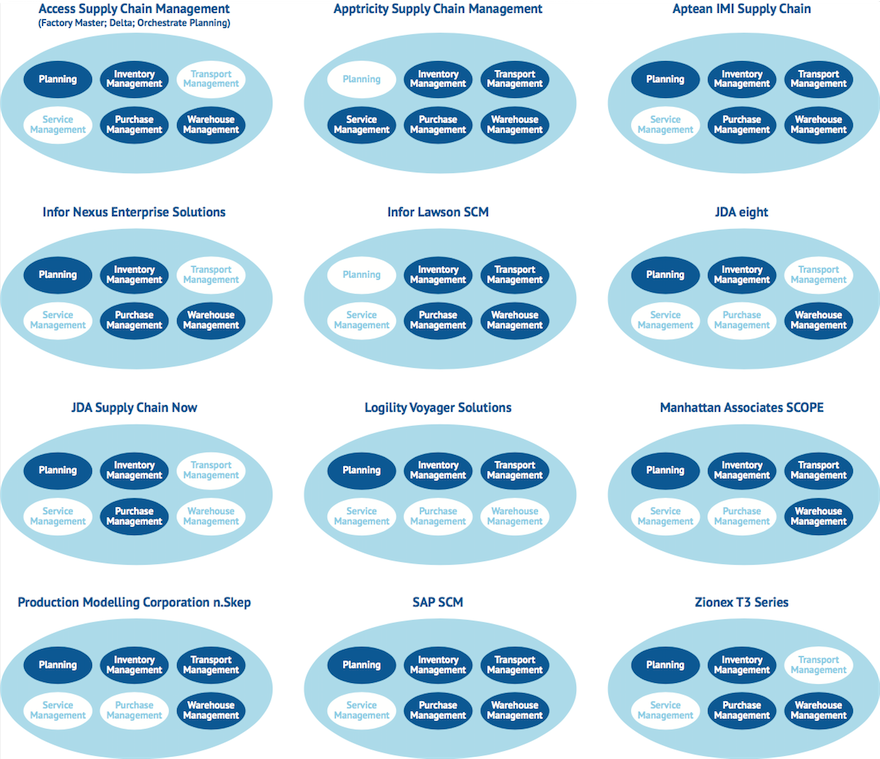
Bloor identified some 6 transport management packages, 5 warehouse management and 9 which combined transport and warehouse management functionality. Obviously these packages concentrate on supporting these two functional categories. However the interesting thing is those that support both TMS and WMS also tend to support inventory management as well. Table 1 shows the products included in the review.
| Trasport Management System (TMS) |
|---|
| DP&C Enterprises DPC SmartFleet (fleet management only) |
| JDA Transport Management Suite |
| Manhattan Associates Carrier (fleet management only) |
| Nuolgx Transportation Mgement System Online (TMS-O) |
| Oracle TMS |
| TMW Systems Enterprise Transportation |
| TMW Appian DirectRoute (routes only) |
| TSi Logistics iVelocity | Warehouse Management System (WMS) |
| Cadre Technologies Accuplus WMS |
| Cadre TechnologiePslaCnnaidngence WMS |
| Core Partners Core WMS |
| IBS Dynaman WMS |
| Viastore Systems viad@t |
| Waer Systems WaerLinx | TMS / WMS |
| Aptean Catalyst WMS |
| High Jump Supply Chain Advantage |
| Inconso Inconso WMS |
| Infor Supply Chain Execution |
| Initechs WAVE |
| Kewill MOVE |
| Manhattan Associates SCALE |
| Tecsys EliteSeries |
| Wolin Design Group Supply Chain Business Suite |

The other SCM functionality areas where vendors have developed specialized solutions are in Planning, Inventory Management and Purchasing. Bloor identified 7 Inventory Management, 13 Planning and 5 Purchasing packages. 2 Inventory Management packages also supported Planning functionality. Table 2 shows the packages reviewed.
Bloor identified some 4 other products that support specialized SCM functionality; these are:
| Planning Software |
|---|
| Adexa eGPS |
| Avercast Forecasting & Demand Planning Software |
| IBS Sales and Operation Planning |
| Infor Sales & Operations Planning |
| Infor Supply Chain Planning |
| LeadTime Technology LTT Suite |
| Logistics Planning Associates PSI Planner |
| NeoGrid Global Supply Chain Collaboration |
| Oracle Demantr |
| Roadmap Millennium |
| Taylor Scheduling Software Taylor Suite |
| Ultriva Collaborative Supply Portal |
| Vecco VCRP | Inventory Management |
| Aptean Vision Inventory Management (includes planning) |
| Cadre Technologies LogiView |
| Datalliance Vendor Managed Inventory |
| Invistics MachSix |
| Park City Group Prescient 5 (includes planning) |
| TCLogic Clever |
| Ultriva Inventory Optimization Tool | Purchasing Software |
| Puridiom eProcurement |
| Puridiom procure-to-Pay |
| SAP Ariba |
| Procurify Purchase Order System |
| Verian Purchase to Pay Suit |
When you start to analyze the suppliers of software in the SCM marketplace, what you find is each vendor supports only some of these pigeonholes and then when you add the requirements related to support field services and mobility support is reduced even more. So to achieve support for the sort of scenario I introduced you may need to consider more than one solution joined using integration or BPM software. Many of the specialized products have been developed to fill gaps in the ERP and SCM products; so they have been built to work with the other packages using standard interface based on XML.
The products other than ERP have developed with their solutions so that they can integrate with an organization’s existing ERP solution. This has been done using XML as the standard base for exchanging data coupled with consultancy support to enable the interface to happen in a smooth controlled manner.
This is still a market in flux, where some consolidation of vendors has occurred. What is interesting is that in some cases where mergers have occurred, the new company is still offering both products. Certain vendors have developed their solutions for a single platform (either UNIX or Windows) and it is interesting to note that the support for the 2 platforms can be very different.
In the main, all the products reviewed can be implemented either in-house or in the cloud (be that private or public). So choice here is not a limiting factor.
This is a high-level review of support for SCM functionality and where it will help readers quickly to determine which products better fit their needs, it does not analyse the depth of functionality support for each pigeonhole. This will be covered in further more detailed reports to come over the next year.

This spotlight report was brought to you in partnership with the software analyst firm Bloor. Click here for more information on Bloor, here for more content from Crozdesk and here to start a software search.